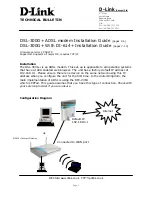
MNC-0500-038
7 of 28
Revision 2
Amplifier Communication and Protocol, XTRT, Touchscreen TWTA
Printable vs. Non-Printable Protocols
Printable protocol facilitates teletype-style operations where users type in
messages and view the responses. There are two drawbacks to this
method:
1) Several responses contain bit flags (example: HPA Summary Status
Query). To force the resulting byte to be printable, bit 6 is conditionally
set. However, there is no guarantee that the resulting byte will not be a
start or stop character.
2) There is no provision for responses to directly indicate the success or
failure of a given message. Rather, the length of the response can be
checked to determine the presence or absence of a message-rejected
code.
Printable protocol drawbacks are remedied by the non-printable protocol.
Because start and stop bytes are non-printable, they cannot be confused
with message parameters, which are always printable. Also, different
start bytes are used to indicate whether a message was accepted or
rejected. For nearly all implementations, the non-printable protocol should
be used.
If you send a message using the printable protocol, devices will respond
using the printable protocol. If you send a message using non-printable
protocol, devices will repsond using the non-printable protocol. There are
no DIP switches to set, and there is no software to configure. Xicom
devices always respond in kind:
•
Printable and non-printable protocols differ only in the characters
used for start, stop, and check bytes. Refer to
Start Byte, End
Byte, & Check Byte
.
•
The "printable" protocol uses printable start and stop characters;
check bytes are generated using a method that produces printable
ASCII characters.
•
The “non-printable” protocol uses non-printable start and stop
bytes; its check byte algorithm can yield non-printable characters.
Refer to
Check Byte Calculation
and examples on Example of
“Base 95”.
EAR EXPORT CONTROLLED: The information contained in this Manual refers or relates to a product that is subject
to the U.S. Export Administration Regulations (EAR). Transfer of data herein by any means to a Foreign Person,
whether in the U.S. or abroad, may require an export license from the U.S. Department of Commerce.
















































